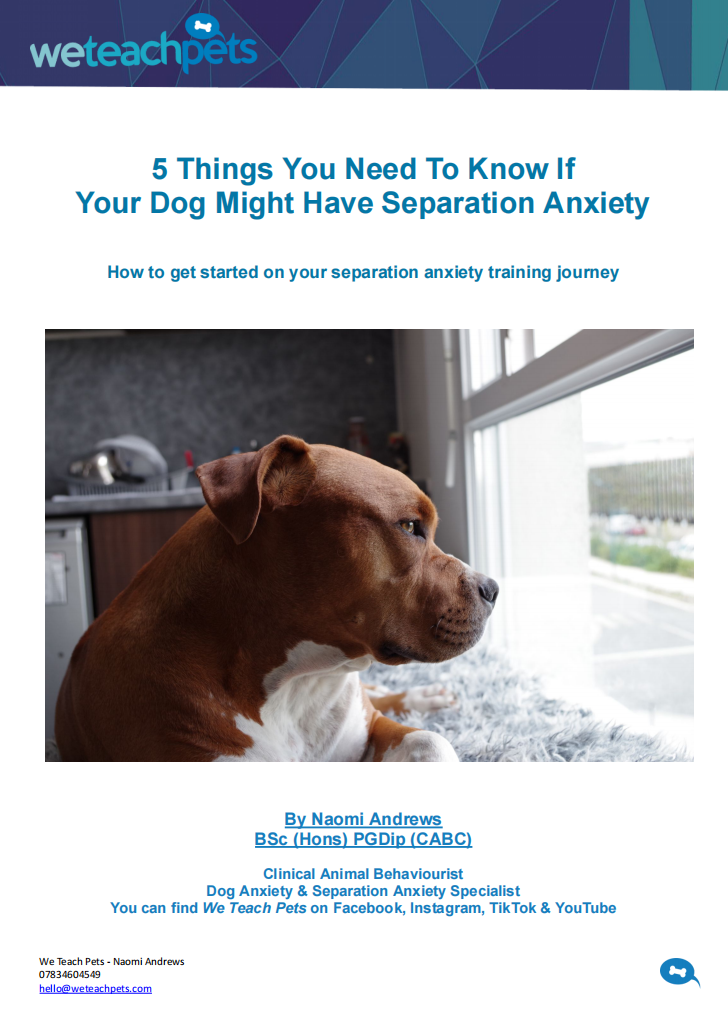Firstly, let me tell you that treating separation anxiety in dogs is possible with the right approach! With the right tools, dogs can learn to spend time alone.

The problem is more common than people think. Owners don’t always realise their dog is anxious until a neighbour mentions some barking or howling. Or in some cases chewing, scratching or toileting in the house is noticed. High numbers of dogs don’t show such obvious signs.
Many of us spent more time home with our pets during COVID lockdowns and discovered new separation problems as we started to leave our dogs alone again. Lots of puppies who were acquired during lockdown never had to learn to be alone as puppies and found it distressing to be suddenly left alone.
Whatever the cause, separation anxiety is undoubtedly stressful for dogs, and can be hugely limiting for their human families. Although we love taking our dogs on outings and adventures with us, there are times where it isn’t feasible for them to come along and they need to stay behind.
So, how do you treat separation anxiety in dogs?
Key considerations before you start separation anxiety training
- Medical conditions which cause pain or anxiety may hamper your training. Pay your vet a visit as your first step, to ensure a clean bill of health.
- Set up a camera to observe your dog so you can see how they are feeling and behaving.
- Become familiar with subtle signs of anxiety. For example you may see your dog pace, hold their ears back, show wide eyes, watch the exits, pant and drool, chew, toilet, vocalise and more.
- Make sure your dogs needs are being met appropriately before you start training. Check out the video below for some enrichment ideas.
There are numerous myths surrounding treating separation anxiety in dogs
Bans on dogs sleeping in owners’ bedrooms or getting on the sofa, needing to spend prolonged periods alone in a room at home before you leave the house, frequently ignoring your dog. Online training plans can seem insurmountable to do alone. Every dog is different. The programme must suit your individual dog’s needs, whilst being realistic.
One aspect that is correct is not to leave separation problems untreated. Dogs with genuine separation anxiety are suffering from the doggy equivalent of a panic attack. The more they experience this, the more anxious they become. They will also start to recognise signs that you might be leaving and start to panic earlier and earlier. The sooner treatment is started, the less ingrained the negative experiences and the better for everyone.
In the meantime, look for ways you can go out without leaving your dog alone. Speak to friends, family, neighbours and colleagues to find people to keep your dog company. Or maybe you can take your dog along with you. Dog sitters and boarders are other great options.
The benefits of 1-2-1 coaching with an expert
What does a separation anxiety training package look like?
My training packages for separation anxiety look a little different than some others. Rather than one session and a long training plan to work through on your own, the steps are split up over multiple sessions with smaller, more manageable goals.
Sessions are carried out online via video call so that your dog behaves precisely as they would do normally, and I can see their responses as they happen. It also means I’m not getting in the way of normal absence training. I can see you and your dog in real time and guide you through the steps as you do them as needed.
I will provide you with a written report after our first assessment session but mostly the programme works around guided “homework” tasks given out each weekday. We then have multiple shorter sessions to catch up, keep up momentum and to continue to set new goals over the course of the training. This means continued support and guidance when things change as you progress.
I am a Clinical Animal Behaviourist based in the Worcestershire area – however, with the online format of separation training you can be anywhere in the world as long as you have your dog and a device with an internet connection! Get in touch to see how I can help https://weteachpets.com/contact-me/
More content for treating separation anxiety in dogs
Free Separation Anxiety Help Here!



